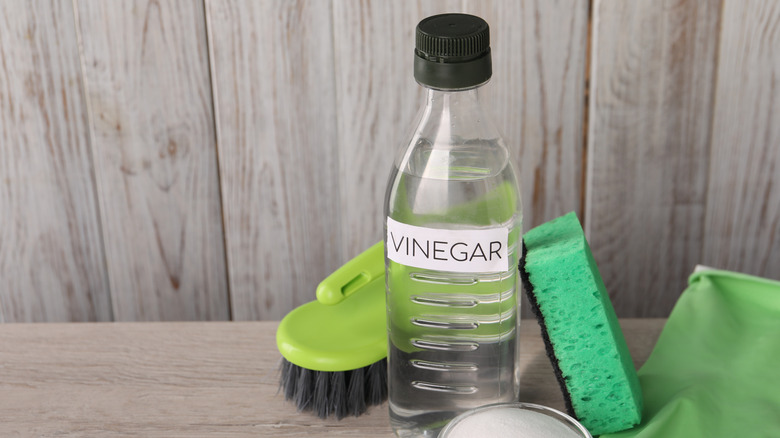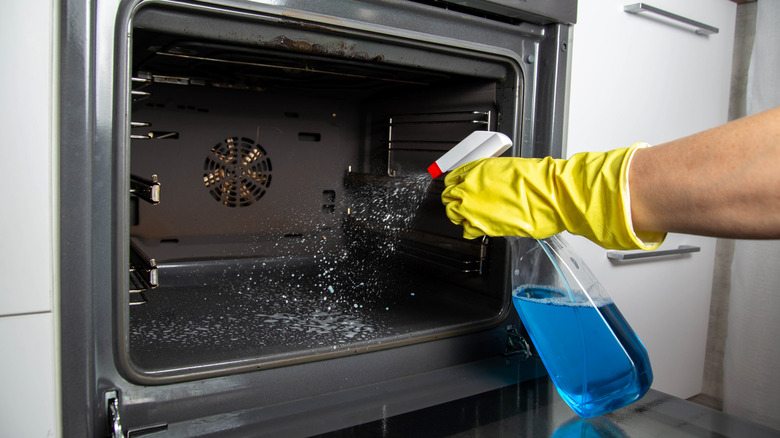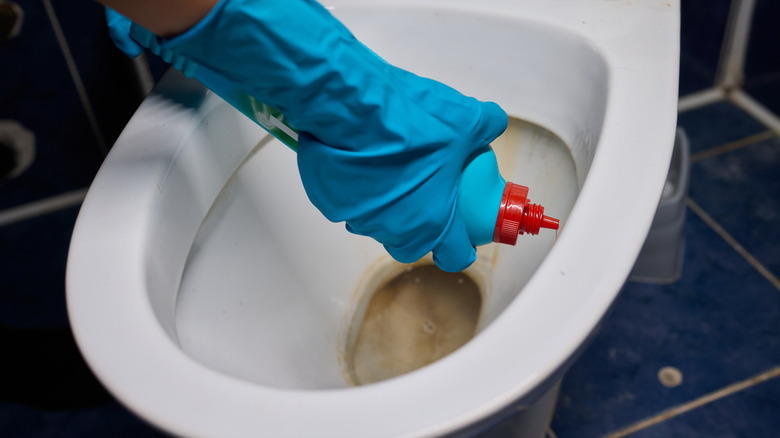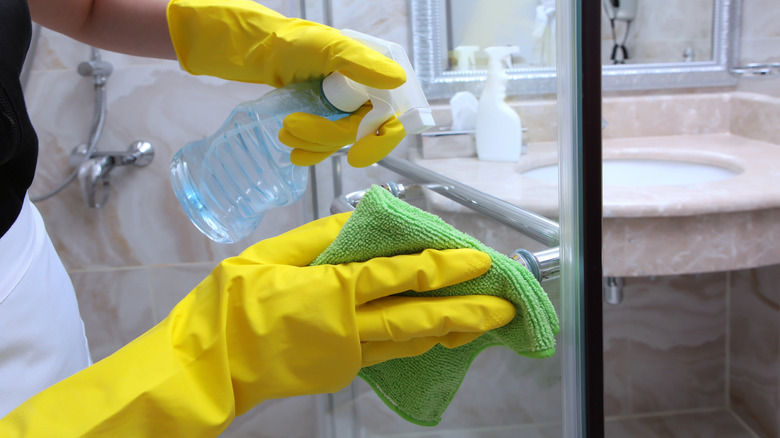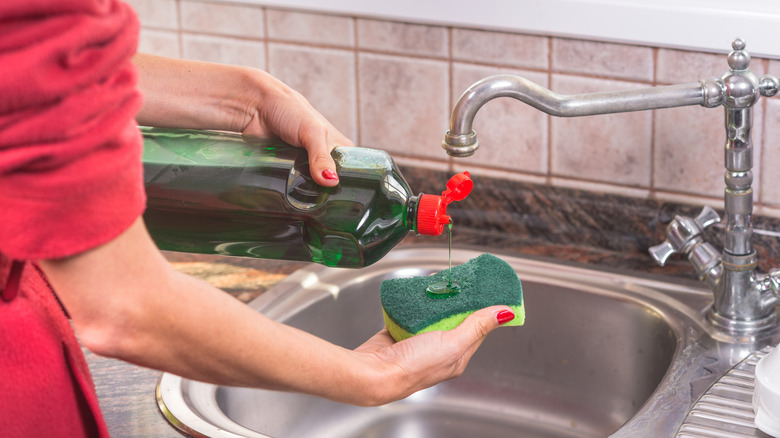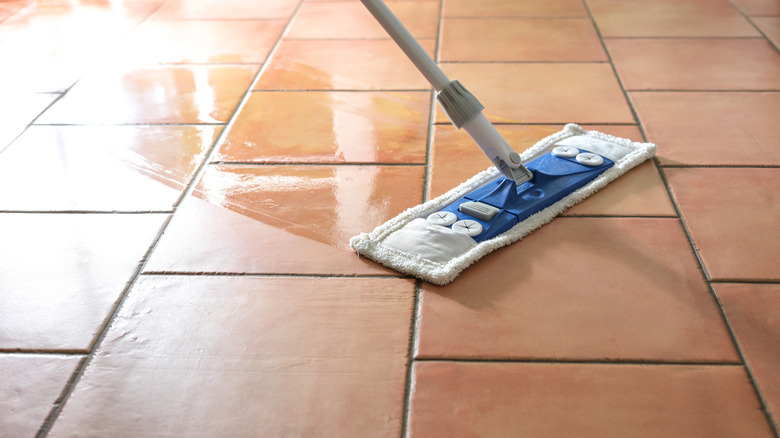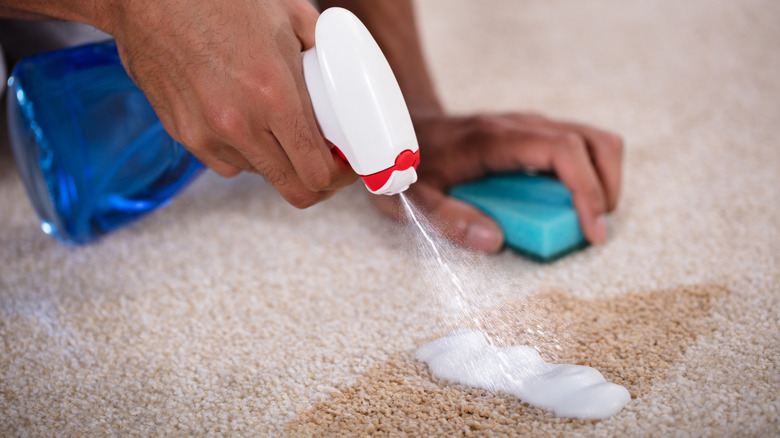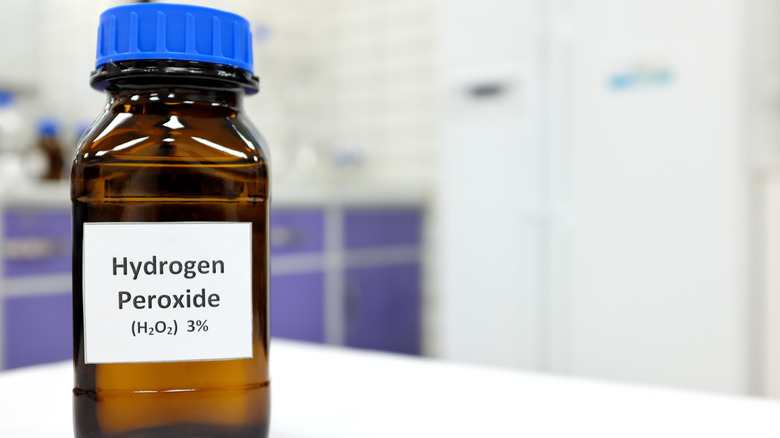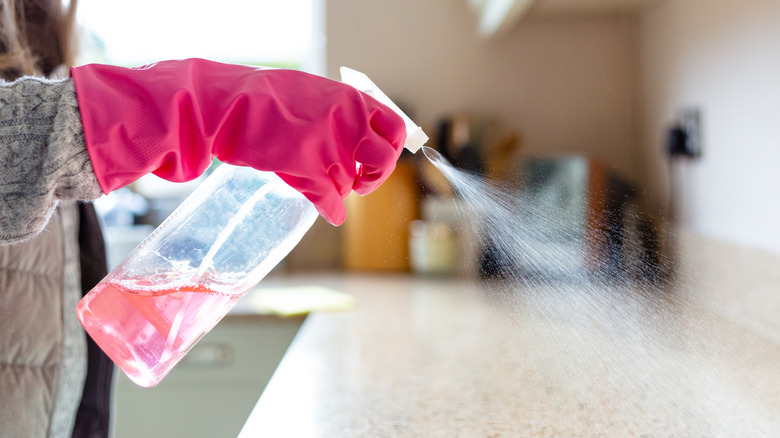14 Common Cleaning Products You Should Never Mix With Bleach
We may receive a commission on purchases made from links.
Liquid bleach is an effective chemical used to whiten fabrics, remove stains, and disinfect household surfaces. However, you shouldn't mix it with certain things, as it can produce dangerous and potentially life-threatening toxic gases or chemical reactions. In fact, the CDC warns against using bleach with any cleaning products in general, just to be on the safe side. This is because it's considered an oxidizing agent. When used by itself, bleach can kill germs and bacteria, but with the wrong substances, it can cause harmful chemical reactions.
Before cleaning your home with bleach, there are several safety precautions to remember. In addition to wearing a mask and gloves and knowing how to properly dilute it, you also need to be careful about using it with other disinfectants and cleaners, like surface sprays, toilet-bowl cleaners, or window cleaning solution. These are cleaning products that you shouldn't mix or use around bleach to ensure you stay safe as you're checking items off your chore list.
Mixing bleach and vinegar creates harmful chlorine gas
Bleach is one of the many common cleaning products you shouldn't mix with vinegar. Since vinegar has an acidic base, mixing bleach with it can create harmful chlorine gas. This can cause a burning sensation in your eyes, throat, or lungs. It can also cause you to develop a cough or suffer respiratory distress. In addition to standard white vinegar or cleaning vinegar, you also want to avoid mixing bleach with cleaning solutions that contain it as an ingredient. These are often products made with natural or eco-friendly substances. This includes but is not limited to brands that produce vinegar-based products like Mrs. Meyer's Clean Day, Aunt Fannie's, Force of Nature, and Windex Vinegar Glass Cleaner.
Luckily, many vinegar-based cleaning products are specifically formulated to clean or tackle tough stains without the need for bleach. Cleaning vinegar is available in higher acetic acid concentrations compared to white vinegar, which makes it more effective at getting rid of stains, soap scum, and grime. Vinegar and rubbing alcohol also make a versatile DIY cleaner combo for all kinds of surfaces, including glass. If you want to use vinegar as a disinfectant, you need the right concentration, plus a bit of citrus. A 2020 study published in BMC Microbiology concluded that vinegar with a 10% acetic acid concentration can act as a disinfectant when combined with 1.5% citric acid.
Bleach and lemon juice can also create chlorine gas
Like vinegar, lemon juice is considered an acid, so it can create chlorine gas when combined with bleach. The 'no lemon juice and bleach' rule also applies to any cleaning products that contain lemon juice, citric acid, citrus oils, and scents. In fact, a study published in the ACS Journal of Environmental Science and Technology proved that a combination of bleach, citrus-scented cleaning or air freshener products, and light exposure can create toxic air particles.
As a safe alternative, opt for cleaning products that have a formulated bleach and lemon-scented combo. For example, Clorox has lemon-scented cleaning products that contain bleach. There are also a bunch of household uses for lemon juice that involve pairing it with vinegar, baking soda, or dish soap. When combined with the right ingredients, lemon juice can get rid of clothing stains, remove rust or grease, and even clean glass surfaces.
When combined, bleach and rubbing alcohol produce chloroform
Rubbing alcohol is used as a household disinfectant, first aid product, and ink stain remover. When used with bleach, the combination can create a dangerous chloroform liquid, which can cause fainting, headaches, dizziness, and nausea. In severe cases, it can even cause organ damage. To ensure safety, refrain from using bleach around products such as OdoBan Disinfectant Laundry & Air Freshener, Windex Multi-Surface products, and some Mrs. Meyer's products, including the glass cleaner and fabric softener.
The good news is that rubbing alcohol is a good disinfectant and stain remover by itself. As mentioned, you can make your own glass cleaner with a combo of rubbing alcohol, vinegar, and water. Be sure to wear a mask to limit your exposure to rubbing alcohol, especially if you're cleaning with it in an enclosed or small space like a bathroom. Also, keep the door open and have a fan close by to help promote air flow.
Avoid mixing bleach with any form of drain cleaner
Drain cleaners use a blend of ingredients designed to dissolve obstructions in tub, shower, and sink drains. This includes strong acids and oxidizing agents, which create toxic gases or fumes when they come in contact with bleach. Some Green Gobbler and Zep drain clog removal products have a percentage of alcohol in them, which could create chloroform when mixed with bleach. Similarly, Mrs. Meyer's drain maintenance cleaners contain citric acid, which could create chlorine gas if paired with bleach.
To prevent these from mixing, never clean bathroom tiles with a tile cleaner that contains bleach at the same time you're using a drain cleaner in a tub or shower drain. However, there are some safe workarounds if you do want to clean drains using bleach. Drano Max Gel Clog Remover and some Liquid Plumr products already have bleach in their formulas.
Bleach and oven cleaning products can create toxic gases
Cleaning your oven with bleach can end in disaster, whether you mix it with oven cleaner or try to use it by itself, as it can erode your oven's protective coating. Oven cleaners are designed to tackle grease, burns, and food residue without damaging the interior surfaces. Many of these contain percentages of alcohol, ammonia, acids, and other chemicals, each of which can contribute to the formation of toxic chloroform, chlorine gas, or chloramine gas when mixed with bleach. Exposure to these substances can cause respiratory distress, eye, nose, and lung irritation, vomiting, dizziness, and loss of consciousness. Easy-Off, Zep, Weiman, and Goo Gone brand oven cleaners are just a few examples of effective products that should never be mixed with or used near bleach.
If you do clean your kitchen surfaces with bleach, space cleaning tasks so that your countertop sanitizing routine doesn't overlap with your oven clean-up. This rule also applies when using a multi-purpose surface cleaner that contains bleach. Try using a mixture of white vinegar and water instead of heavy-duty cleaners for a natural, chemical-free oven cleaning solution. Just remember, vinegar also should never be used around bleach, either.
Never use bleach with toilet bowl cleaner for your safety
Toilet bowl cleaners are typically liquid solutions or disposable scrubbers used to sanitize and remove stains in the toilet bowl. Phosphoric acid is commonly found in toilet bowl cleaners, which can create chlorine gas and contribute to breathing issues and eye irritation when mixed with bleach. Similarly, some toilet bowl cleaners contain ammonia, which can create chloramine gas, also a harmful substance. Some examples of toilet bowl cleaners that shouldn't mix with bleach include: Seventh Generation, Lysol, and Zep Acidic toilet bowl cleaners.
To be on the safe side, only use toilet-bowl cleaners that have a mix of bleach already, like Clorox Toilet Bowl Cleaner Clinging Bleach Gel. You can also use a cleaner in combination with an electric toilet-bowl brush to remove tough residue. Remember, always wear a mask and never mix bleach-free toilet-bowl cleaners with bleach by itself. Also, refrain from using toilet bowl cleaner while sanitizing nearby areas with bleach at the same time.
Exercise caution with bleach and laundry stain removers
There's a wide variety of laundry stain removers specifically designed to target difficult stains, and most of them have some form of acid in them to help break down food or liquid particles. Their acidic properties prove dangerous when they come in contact with bleach, since together, they form chlorine gas. Because of this, bleach and laundry stain removers should never be mixed together or used in close proximity.
However, there are a few exceptions. For example, Clorox says it's fine to use Clorox Disinfecting Bleach and OxiClean Laundry Stain Remover Spray together, since they don't have any chemicals or substances that would react when combined. Otherwise, avoid the risks by first using a stain remover before thoroughly rinsing the item and giving it ample time to dry. If stains or odors persist, you can use a diluted bleach solution by itself to sanitize and clean laundry safely.
Bleach and glass cleaners are a dangerous combo
Glass cleaners are used to clean mirrors, windows, and shower enclosures. However, it's important not to use bleach with or around glass cleaners like Windex due to the potential ammonia content. When combined, these form chloramine gas, which can cause mild irritation all the way up to nausea and vomiting, shortness of breath, and organ damage. Glass cleaners that contain vinegar, such as Windex with Vinegar and Aunt Fannie's Glass and Window Cleaner also shouldn't be mixed or used around bleach due to their acidity, which can create toxic chlorine gas.
For your safety, only use glass cleaners as directed by the product's manufacturer. And when using them, refrain from using bleach to clean other surfaces in the same vicinity (like cleaning a bathroom mirror while sanitizing the countertop). This might mean spacing out your cleaning routine so that bleach and glass cleaner aren't used at the same time.
Bleach and dish soap can form toxic gases
Bleach can be used around the kitchen to disinfect surfaces and dishes, but did you know it shouldn't be used with dish soap? Dish soap can sometimes contain acids and other ingredients that contribute to the creation of toxic gases when paired with bleach. This can cause you to experience nausea, headaches, and respiratory discomfort. Brands like Dawn, Gain, and Palmolive all have dish soaps with a combination of ingredients that don't mix well with bleach.
The USDA recommends a 'clean then sanitize' approach for adequately ridding your dishes of germs and bacteria. So, if you do feel the need to sanitize dishes with bleach to kill germs and food-borne pathogens, only use it after you've washed with dish soap, rinsed, and dried the dishes. Does your dishwasher have a sanitizing cycle? Use this instead and leave the bleach out altogether.
Bleach and hard floor cleaners don't mix
Hard floor cleaners include everything from wood floor formulas to tile-cleaning products, each with its own unique mix of ingredients, so there's a lot of risk if you mix bleach with them. This is especially true for ammonia-based floor cleaners due to the potential to create chloramine when paired with bleach, which can cause you to experience a laundry list of symptoms, from eye, nose, and throat irritation to pneumonia or respiratory discomfort. Floor cleaners can also have rubbing alcohol in them, which negatively reacts with bleach and has the potential to harm your lungs, nervous system, and vital organs.
For the best results, start by using a hard floor cleaner. If needed, you can use a diluted bleach mixture once the floor's surface has been rinsed and dried. Also, make sure to thoroughly rinse any mops, sponges, and cleaning tools you used to clean your floors before using them with bleach. If you don't rinse the mop head, some of the cleaning solution could still be present and cause a reaction. Consider using a mop that comes with replaceable heads, like O-Cedar's EasyWring Mop, to make the process a breeze.
Think twice before using bleach with carpet cleaners
Just like hard floor cleaners, carpet cleaning solutions should never be used with bleach. For example, OxiClean Carpet and Rug Pet Stain & Odor Remover Spray contains both hydrogen peroxide and pentetic acid, both of which should never be mixed with bleach due to the potential for harmful gases or reactions. Hydrogen peroxide and bleach can have a potentially explosive reaction — especially when mixed together in a spray bottle or another closed container. Plus, mixing bleach and acids can cause various symptoms from burning sensations in your eyes and throat to lung issues and even death.
When in doubt, refrain from using bleach altogether and use vinegar, baking soda, or a trusted cleaner brand to freshen up your carpeted floors and rid them of stains. Since bleach can cause discoloration on certain fabrics and colors, it's really best to avoid using it on your carpets. However, if you know yours can handle bleach, consider using it in a carpet cleaning vacuum. These handy cleaners help to evenly distribute the liquid onto carpets to prevent too much from depositing on one area. Just make sure that the model can handle diluted bleach before you begin. Also, make sure to wash and rinse the reservoir before adding bleach to it, in case the carpet cleaning solution is still inside from a previous use.
Keep bleach and hydrogen peroxide separate
Hydrogen peroxide can be used to brighten white clothes, remove stains, and disinfect surfaces, making it a handy chemical to have around the house. However, make sure to never use it with or around bleach, since these two have the potential to create oxygen gas, which could trigger an explosive event. This also goes for any cleaning products that use hydrogen peroxide as an ingredient. Examples include some Lysol cleaners, Bissell stain removers, and OxiClean products.
To maintain a safe environment, store bleach and hydrogen peroxide away from one another, and consider sticking to one for disinfecting and stain removal. Hydrogen peroxide likely won't tackle tough stains or kill bacteria at the same level as chlorine bleach, but it can still do the trick if that's all you have on hand. If you do have both bleach and hydrogen peroxide stored in your home, ensure that both are properly labeled.
Be mindful about using bleach near all-purpose cleaners
Keep bleach away from all-purpose cleaners or multi-surface sprays since many of them contain vinegar, baking soda, ammonia, or acidic components, which react negatively with bleach and pose certain health risks. Examples include Mrs. Meyer's Clean Day, Morton Pro, and Mr. Clean all-purpose cleaners to name a few. Depending on the ingredients used, mixing these can cause instances of nausea, vomiting, burning or irritation of the eyes and throat, shortness of breath, chest pain, or organ damage.
That being said, there are all-purpose cleaners formulated to both clean and disinfect surfaces. Some examples include Clorox Disinfecting All Purpose Cleaner Spray, which kills germs and bacteria without bleach, and Lysol multi-purpose sprays, which are formulated with or without bleach or hydrogen peroxide. Comet Ultra All-Purpose Cleaner with Bleach is another suitable alternative, since it's designed to clean and disinfect simultaneously. In addition, never mix two different all-purpose cleaning sprays, or any cleaners in general, since you don't know how their ingredients will react with one another.
Refrain from using bleach near rust cleaners
Rust cleaning solutions help remove corrosion from metal pots, tools, or household appliances to preserve their quality. However, rust cleaners usually contain acidic ingredients, which makes them incompatible to use with or around bleach. When combined, bleach and rust cleaners can form harmful chlorine gas, which can cause eye, nose, or throat irritation in addition to more severe symptoms. Therefore, never mix bleach with rust removal products like Lime-A-Way, Iron Out, or Whink Rust Stain Removal.
To ensure your safety, be extra mindful when cleaning areas that you also clean with bleach, like shower enclosures, sinks, or dishwashers. If you just cleaned an area with a product that contains bleach, rinse the solution or wait for it to dry before using rust removal products. When applying rust cleaners to household surfaces, always wear gloves and consider wearing a mask and goggles to help limit inhalation and skin exposure.

